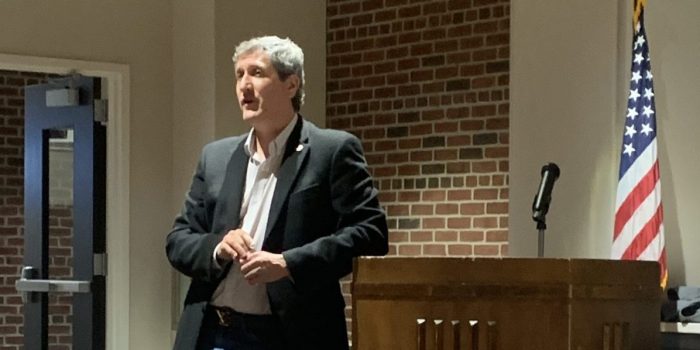Imagine a world where a child growing up on Long Island does not have the opportunity to climb aboard a 19th century streetcar and learn about the desegregation of public transportation in New York; or to learn who carved the sculptures in Central Park; or be able to look up in awe at the colossal skeleton of a whale and learn about the industry that built and sustained our region. This is the world that will be created if the elimination of federal agencies and grants that support our local libraries and museums are not stopped.
Three of Long Island’s most beloved cultural institutions on Long Island’s North Shore —The Whaling Museum & Education Center of Cold Spring Harbor, The Heckscher Museum of Art in Huntington, and The Long Island Museum in Stony Brook—are facing the abrupt and unprecedented termination and suspension of grant funding from two federal agencies: the National Endowment for the Humanities (NEH), which was terminated by executive order by the presidential administration at the start of April, and the Institute of Museum and Library Services (IMLS), where already-approved project funding is now halted or terminated.
The three museums were awarded federal grants to support public-facing projects, including exhibitions and community programming. But now, these NEH funds have been withdrawn and IMLS funds frozen with little, if any, explanation. A termination letter sent to The Whaling Museum by Michael McDonald, the Acting Chairman of the NEH, stated “the NEH is repurposing its funding allocations in a new direction in furtherance of the President’s agenda” and that “immediate termination is necessary to safeguard the interested of the federal government.” The three museums are among thousands of museums, libraries, and educational institutions who have suddenly lost funding.
Impacts
At The Whaling Museum in Cold Spring Harbor, the cancellation rescinds funding supporting exhibition design for a museum expansion centered on a whale skeleton to provide needed community space, and freezes funding for year-round educational programming tied to the museum’s Monsters & Mermaids exhibition.
At The Heckscher Museum of Art, award funds were to support the development of a groundbreaking new exhibition Emma Stebbins: Carving Out History, devoted to the sculptor who is best-known for her Bethesda Fountain in Central Park, along with a robust year of exhibitions and public programming supporting an intergenerational group of community members focused on enhancing teen mental health through the creation of art and fostering of community connections.
At The Long Island Museum, the IMLS funding cancellation blocks efforts to build an interactive and immersive exhibition experience in the museum around its circa 1885 horse-drawn streetcar. The exhibition, titled Riding Towards Justice, was to have created an accessible climb-aboard experience for visitors of all ages who would also learn of the stories of Elizabeth Jennings Graham (1827-1901).

“These grants weren’t gifts—they were intentional investments grounded in research demonstrating the positive impacts of humanities-based projects addressing the educational needs in our communities,” said Nomi Dayan, Executive Director of The Whaling Museum. “We have a 90-year history of serving Long Island with integrity and creativity, and we are proud to preserve one of the most significant times in American history. The abrupt withdrawal comes at a cost to the communities we serve. We’re asking our leaders to honor the commitments that were made, and prioritize the learning that takes place in museums.”
“Thousands of studies, including a recent 2024 report released by The World Health Organization, have concluded that involvement in the arts can improve public health and promote healing from illness, cognitive decline, heart disease, anxiety and depression,” shared Heather Arnet, CEO and Executive Director of The Heckscher Museum of Art. “The Heckscher Museum of Art project which had been awarded a grant from IMLS was developed specifically with these social determinants of health in mind.”
“The Long Island Museum has received multiple IMLS grants for our Carriage Museum since the late 1980s that have supported conservation of the collection, improved exhibitions, and great programming. We are heartbroken over these actions and the potential loss this represents for our community and our different groups of visitors,” said Joshua Ruff, Co-Executive Director of the Long Island Museum.

Collectively, these three museums serve hundreds of thousands of residents and visitors annually; reach more than 100 school districts; introduce tens of thousands of school children each year to their first brush with art and history; and help senior community members develop meaningful engagement and connection opportunities later in life. The programs made possible through NEH and IMLS funding help provide equitable access to culture, spark lifelong learning, and preserve America’s stories.
Eliminated funding not only impacts the educational capacity at the museums, but has an economic impact on the region as a whole. A recently released Economic Impact Study by The Long Island Arts Alliance found that the nonprofit arts sector generated $330 million in economic activity during 2022—$178.4 million in spending by arts and culture organizations and an additional $151.6 million in event-related expenditures by their audiences. That economic activity supported 4,905 jobs, provided $234.5 million in personal income to residents, and generated $81.2 million in tax revenue to local, state, and federal governments.
Taking action
Museums are calling on their supporters, elected officials, and the broader public to speak out to encourage Congress and the Administration to reinstate the legally awarded grants and protect the integrity of the nation’s cultural funding process.
The public can show their support by visiting The Whaling Museum & Education Center, The Heckscher Museum of Art, and The Long Island Museum on “International Museum Day” on Sunday, May 18. All visitors to the three Museums that day will receive special “IheartMuseums” pins, stickers, and additional information on ways to help.
To learn more about the impact of these cuts or to take action, please visit the websites of the three museums — hecksher.org; cshwhalingmuseum.org, and longislandmuseum.org.


















